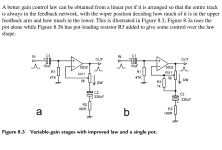In Doug Small's book "Small Signal Audio Design" he suggests we get better control over our gain control by having the pot straddle to two feedback networks. However, I barely ever see pedal designs utilise this. Is there a downside? One I can foresee is that we might change the value of the high pass filter, which would affect frequency response. Maybe this is a good thing though if the highpass filter becomes higher in frequency as gain increases?


